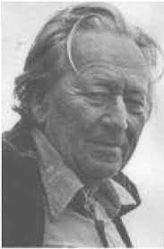EUROPEAN FAMILY THERAPY ASSOCIATION
CONNECTING FAMILY THERAPISTS AND TRAINERS
Gregory Bateson
Born in 1904, he graduated in biology at Cambridge

Umberta Telfener: I worked at the Philadelphia Child Guidance Clinic from 1976 to 1979 and I trained with Sal Minuchin and Jay Haley, with Harry Aponte, Braulio Montalvo and others. On the many occasions in which Bateson would pass and propose lunch to Jay Haley (they had worked together on the Rockefeller Grant on double bind), sometimes they would ask me to join them. I would go to lunch feeling very honored and emotional, keen to understand everything that was said. I was hoping to receive a picture of creative transformation, I was therefore very concentrated and focused. Each time I would end up sobbing in my room because I had not enjoyed the lunch enough, I had not understood enough. Bateson was passing from one topic to the next and I was making the mistake of trying to understand each passage. I had not realized that he used to communicate in a primary process manner and that there was no rational to the conversational flux that was abductive. I should have enjoyed the dance, I should have followed the flow, as you do with a family when understanding too much becomes an impediment instead of a resource.
Giovanni Madonna: I want to let you in on a secret. It is commonly believed that the introduction of the observer into the field of observation occurred in the early 1980s, with the advent of second-order cybernetics (von Foerster, 1981), but this is not the case. Gregory Bateson, in fact, anticipating in some respects the development of cybernetics, included the observer in the field of observation as early as the 1950s.
In a text written with Ruesch, the English scientist stated: “In physics and to some extent in anthropology and other sciences, including history in particular, it is now realized that the observer and even the theorist must be understood within the systems being analyzed. The theories of physics and the statements of historians are equally human constructions and can only be understood as products of an interaction between the data and the scientist, who lives in a given epoch and culture” (Ruesch, Bateson, 1951, p. 285). In 1959, in an if possible even more explicit manner, Bateson argued: “The observer must be included in the field of observation, and what can be studied can only be an infinite relation or regress of relations. Never a thing” (1972, p. 290).
With the advent of second-order cybernetics in the early 1980s, however, the introduction of the observer into the field of observation was rescued from the oblivion into which it had fallen; its importance was emphasized and relaunched, and it slowly spread among professionals and scholars, partly by virtue of the fact that the cultural temperament prevailing at the time made professionals and scholars more ready to embrace it.
Juan Linares: Meeting Nora Bateson once – she had come to show her film about her father – I asked her why her father could say that emotions are dormant. I added that it had been detrimental to the therapy because following her words the emotions had been relegated to the background. Nora replied: “My father certainly didn’t write this. It is more likely that Paul Watszlawich wrote it and thought it and attributed it to Dad. He was the one who was afraid of emotions.”
Umberta Telfener: Giorgio Nardone, Italian strategic psychotherapist who worked with Paul Watzlawick for many years, told me this story. Paul had presented his book Pragmatics of Human Communication to the Norton publishing company and they had accepted the project. When he told Bateson, the master got very upset: “Your book is like a description of the Hawaii islands, very different from the Hawaii Islands”. Watzlawick found out quite immediately that Bateson had submitted his book “Towards an ecology of mind” to the same publishing company and they had not jet accepted it.
Camillo Loriedo: Bateson one day encounters Haley and complains: “Erikson has hypnotized me, convincing me to have lunch with him!”. “How did he do this?” Haley asks. “He has asked me if I would have lunch with him”.



